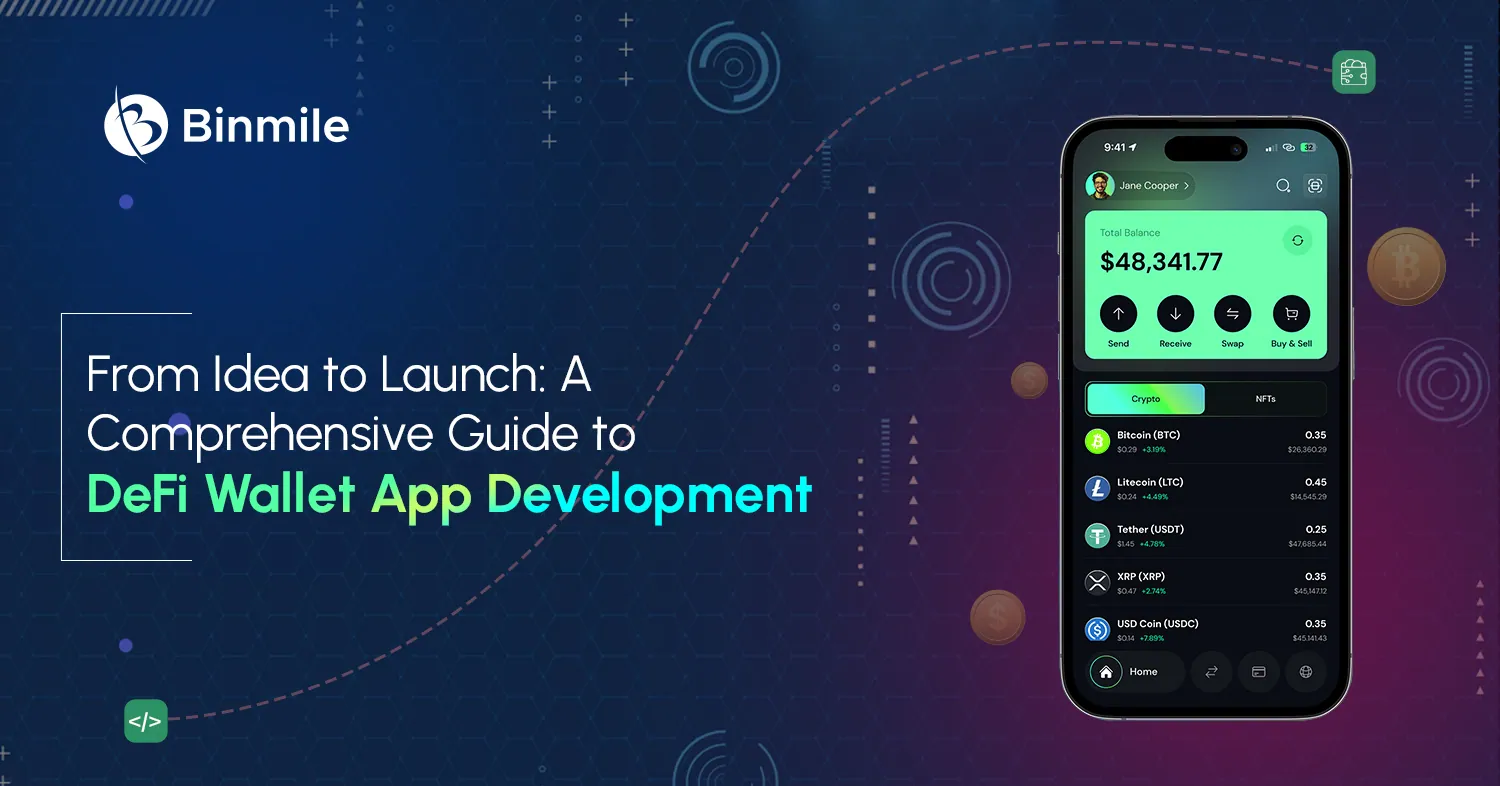There’s no doubt the digital age has redefined technology and its use. It hfas brought innovations and technological advancements; among them is decentralized finance or DeFi. It’s the use of blockchain in FinTech and cryptocurrencies to offer traditional financial services without the need for intermediaries like banks. DeFi systems run on smart contracts, primarily on networks like Ethereum. As DeFi platforms continue to revolutionize the BFSI sector without intermediaries and decentralize financial services for all, there’s one more toolset to transform the entire ecosystem: the DeFi wallet.
DeFi is a self-custody crypto wallet that allows users to store cryptocurrency and connect to decentralized applications. DeFi wallet lets you access your wallet mandates utilizing not only passwords but also key phrases or seed phrases. Providing strong security and an avenue for accessing diverse products and services, the opportunity to build decentralized applications and crypto assets also exists. This level of control over digital assets naturally pleases users but there are other benefits for businesses. So, let’s understand them. In addition, in this complete guide to DeFi wallet app development, we’ll also discuss what is a defi wallet, app development cost, and how they function.
What is a DeFi Wallet?
Simply defining, at its core, a DeFi wallet works like any digital wallet; which is to store, send, and receive decentralized tokens and interact with DeFi platforms. However, there’s a difference, as traditional wallets store fiat currencies, a DeFi wallet stores cryptographic keys—both private and public keys.
DeFi Wallet App Development: Future Outlook
DeFi market is set to reach an all-time high of US$26,170 Million in 2024. This revenue is further expected to show a CAGR of 9.07% during the forecast period from 2024 to 2028. It will result in a remarkable projected amount of US$37,040 Million by 2028.
Before we understand how DeFi wallet works, let’s understand the concept behind DeFi or Decentralized finance. Decentralized Finance, or DeFi, is a blockchain-based financial system that operates without traditional intermediaries like banks.

- Smart Contracts: Smart contracts or self-executing code to automate financial services and transactions. In DeFi, users interact through digital wallets, accessing a range of services 24/7. These include lending and borrowing, where individuals can earn interest on their cryptocurrency or take out loans using their digital assets as collateral.
- Decentralized Exchanges: DEXs allow direct peer-to-peer trading of cryptocurrencies, bypassing centralized platforms. Often accessed through a decentralized trading app, these exchanges are powered by liquidity pools, where users deposit assets to facilitate trading.
- Yield farming: This is where users stake or lend their tokens to earn rewards, and is another key DeFi activity. It provides liquidity to the ecosystem. DeFi also enables more complex financial instruments, such as synthetic assets and prediction markets, previously limited to institutional investors.
While DeFi offers increased accessibility and transparency, it also carries risks due to its being in its nascent form and the volatility of cryptocurrency markets. As the sector matures, it has the potential to significantly reshape global financial services.
Benefits of DeFi wallets
There are some benefits of having DeFi wallets for your business, let’s understand them:
- Users maintain full control over their assets and private keys.
- Tokens in non-custodial wallets are protected from hackers, in contrast to CEX-stored funds.
- It lets users get early access to emerging tokens and Web3 projects
- It facilitates easy asset transfer between DeFi wallet blockchains, e.g., Ethereum and BNB Chain.
How to Develop a User-Friendly DeFi Wallet App: 7 Easy Process to Check
Decentralized Finance (DeFi) has revolutionized the financial landscape with secured and personalized finance apps, and DeFi wallet apps are at the forefront of this transformation. If you’re looking to develop your own DeFi wallet app, here’s a comprehensive guide to help you through the process:

1: Conceptualize Your DeFi Wallet
Define the scope and purpose of your wallet. Determine which cryptocurrencies and tokens it will support, what DeFi protocols it will integrate with, and what unique features will set it apart. Consider whether you want to focus on specific DeFi activities like yield farming, liquidity provision, or decentralized exchanges.
2: Choose Your Blockchain Platform
Choosing the right DeFi wallet blockchain platform for your wallet is crucial for security, efficiency, and scalability. Evaluate the features of each platform and make choices based on it. Ethereum is the most popular for DeFi, but consider alternatives like Binance Smart Chain, Polygon, or Solana for lower fees and faster transactions. Multi-chain support can broaden your user base and offer more flexibility.
3: Design the Wallet Architecture
Plan your wallet’s technical structure. This includes deciding on hot or cold storage options, implementing secure key management systems, and designing the wallet’s interaction with blockchain networks. Consider using standards like BIP39 for mnemonic phrase generation and HD wallet derivation paths.
4: Develop the User Interface
Create an intuitive, user-friendly interface that makes it easy for users to manage and track their transactions. Focus on clear navigation, real-time portfolio tracking, and easy-to-use transaction features. As this shortens the learning curve and encourages users to confidently embrace digital wallet development. Don’t forget to ensure your design is responsive and works well across different devices and screen sizes.
5: Integrate DeFi Protocols
Connect your wallet to popular DeFi protocols. This involves implementing smart contract interactions, token swaps, and liquidity pool management. Ensure smooth integration with decentralized exchanges (DEXs) and lending platforms. Use Web3 libraries to facilitate these interactions.
6: Implement Robust Security Measures
Security is paramount in DeFi. Incorporate robust cybersecurity practices, including end-to-end encryption, secure key storage, and multi-factor authentication. Consider hardware wallet integration for enhanced security. Implement measures to protect against common vulnerabilities like phishing attacks and private key exposure.
7: Test, Deploy, and Maintain
Conduct thorough testing, including security audits and user acceptance testing. Deploy your app on relevant app stores and create a marketing strategy to attract users. Post-launch, provide regular updates, monitor performance, and stay responsive to user feedback and emerging DeFi trends.
Achieve cost-effective DeFi wallet development without compromising on quality. Work with us to create secure, scalable, and reliable wallets tailored to your needs!

How Does a DeFi Wallet Work?
A DeFi wallet is essentially a digital container for your cryptocurrency assets. Unlike traditional bank accounts, it doesn’t hold your funds directly. Instead, it stores the cryptographic keys that prove ownership of your assets on the blockchain. Just like how decentralized finance uses smart contracts to enable peer-to-peer interactions on the Ethereum blockchain, DeFi also works similarly. Here’s a short breakdown of how it works:
- Generate Keys: When you create a DeFi wallet, it generates a pair of cryptographic keys:
- Public Key: This is like your wallet address. You share it with others to receive funds.
- Private Key: This is the secret key that proves ownership of your wallet.
- Store Assets: When you acquire cryptocurrency, it’s recorded on the blockchain. Your wallet’s public key is linked to these records. However, the actual coins aren’t stored in the wallet itself.
- Transactions: When you send cryptocurrency, your wallet uses your private key to create a signed transaction. This transaction is broadcast to the blockchain network.
- Verification: Network nodes verify the transaction using your public key and if valid, then the transaction is added to the blockchain, updating ownership records.
Know the Difference: Decentralized Apps vs Traditional Apps
Types of DeFi Wallets
While there are various DeFi wallets, they can generally be categorized as:
- Hardware Wallets: Physical devices (like USBs) that store your private keys offline and are immune to online hacking attempts.
- Software Wallets: These are apps or software-based solutions, while convenient, they are online and potentially more vulnerable.
- Web Wallets: These can be accessed through web browsers such as MetaMask and WalletConnect, if used through authentic websites, they’re quite safe.
- Mobile Wallets: Smartphone apps that offer convenience on-the-go financial services.
- Paper Wallets: These are physical documents that contain both your public and private keys.
5 Factors Influencing DeFi Wallet App Development Costs
How Much Does It Cost To Build DeFI Wallet Apps?
To tell you what the fintech app development cost for apps like the DeFi wallet app is, it can range from $20,000 to over $200,000. This too depends on various factors such as application complexity, choice of blockchain network, design intricacy, security measures, and the development team’s expertise. Let’s understand them in detail.
1. App Complexity
The scope of features directly impacts development costs, so before you opt for any mobile app development company, consider these:
- A basic wallet with core functionalities like sending, receiving, and storing cryptocurrencies typically ranges from $50,000 to $100,000.
- Intermediate wallets with added features like staking and swapping can cost between $100,000 and $150,000.
- Advanced wallets offering complex functionalities such as NFT management and DEX integration often start at $150,000 and can escalate significantly.
2. Choice of Blockchain Network
What type of blockchain network you’re going to use also impacts cost. For instance, ethereum, while popular, is known for high gas fees, impacting development budgets. Binance Smart Chain (BSC) generally offers lower costs but might have trade-offs in terms of ecosystem and liquidity. Other blockchains vary in terms of fees and development complexities.
3. Design and User Experience (UX)
Invest in a robust design and intuitive UX to enhance user satisfaction. A basic design with minimal customization can range from $20,000 to $50,000. Custom designs with advanced UX features can cost between $50,000 and $100,000 or more. Iterative design processes involving user testing and refinements add to the overall cost.
4. Security Measures
Keeping the app is essential since your wallet is connected to the internet and vulnerable to online attacks. If basic security measures like encryption and authentication can cost around $20,000 to $40,000, then advanced security features including multi-factor authentication, cold storage, and regular security audits can range from $40,000 to $80,000 or more. Don’t forget to consider compliance with regulations like KYC/AML, as it also contributes to the overall cost.
5. Development Team Expertise
The choice of a development team significantly impacts costs. In-house development can be expensive due to salary, infrastructure, and overhead costs. Outsourcing app development services can be more cost-effective but might involve trade-offs in terms of quality, communication, and project management. However, do consider other factors related to geographical location, the team’s experience, and project scope.
Join the $26B DeFi revolution! Contact us for expert wallet app development services and gain a competitive edge in fintech today.

Closing Statement
The DeFi landscape is dynamic and constantly evolving and there’s no doubt it brings a lot of advantages for the BFSI sector as well as users. However, developing a DeFi wallet app is complex but it doesn’t have to be an overwhelming task. It requires a deep understanding of blockchain technology, cryptography, user experience design, and robust security protocols. Each part of your software development cycle is crucial for the success of the project be it designing or testing. One cannot sideline security and compliance with regulatory frameworks. Hopefully, this guide has helped you understand the nitty-gritty of developing a DeFi wallet so that you can transform a DeFi wallet idea into a fully functional and secure application.
If these outlined steps seem overwhelming, you can see the help of a fintech app development company expert in blockchain financial services, offering custom software development solutions to elevate your digital transformation journey. Get in touch today and boost your chances of creating a successful DeFi wallet app that caters to the growing demand for decentralized financial services.
Frequently Asked Questions
- Non-Custodial Control: Users have complete ownership of their private keys and funds.
- Multi-Asset Support: Support for various cryptocurrencies like Ethereum, Bitcoin, and ERC-20 tokens.
- dApp Integration: Seamless access to decentralized applications.
- Security Measures: Advanced encryption, multi-factor authentication, and biometric security.
- Cross-Platform Accessibility: Available on mobile, web, and desktop platforms.
- Staking and Yield Farming: Access to earning opportunities through staking and liquidity pools.
- End-to-End Encryption: Protects sensitive data during transmission.
- Private Key Management: Ensures secure storage and user control over keys.
- Multi-Factor Authentication (MFA): Adds an extra layer of protection.
- Smart Contract Audits: Regular audits to identify vulnerabilities.
Partnering with a specialized DeFi wallet development company ensures:
- Expertise in cutting-edge blockchain technologies.
- Custom-built solutions tailored to business needs.
- Compliance with industry standards and security practices.
- Ongoing support for scalability and updates.









